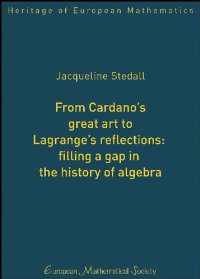This book is an exploration of a claim made by Lagrange in the autumn of 1771 as he embarked upon his lengthy "Réflexions sur la resolution algébrique des equations": that there had been few advances in the algebraic solution of equations since the time of Cardano in the mid sixteenth century. That opinion has been shared by many later historians. The present study attempts to redress that view and to examine the intertwined developments in the theory of equations from Cardano to Lagrange. A similar historical exploration led Lagrange himself to insights that were to transform the entire nature and scope of algebra. Progress was not confined to any one country: at different times mathematicians in Italy, France, the Netherlands, England, Scotland, Russia, and Germany contributed to the discussion and to a gradual deepening of understanding. In particular, the national Academies of Berlin, St. Petersburg, and Paris in the eighteenth century were crucial in supporting informed mathematical communities and encouraging the wider dissemination of key ideas. This study therefore truly highlights the existence of a European mathematical heritage. The book is written in three parts. Part I offers an overview of the period from Cardano to Newton (1545 to 1707) and is arranged chronologically. Part II covers the period from Newton to Lagrange (1707 to 1771) and treats the material according to key themes. Part III is a brief account of the aftermath of the discoveries made in the 1770s. The book attempts throughout to capture the reality of mathematical discovery by inviting the reader to follow in the footsteps of the authors themselves, with as few changes as possible to the original notation and style of presentation. A publication of the European Mathematical Society (EMS). Distributed within the Americas by the American Mathematical Society.
In Collection
#7504
Read It:
Yes
#7504
Read It:
Yes
Mathematics
|
|
||||||||
